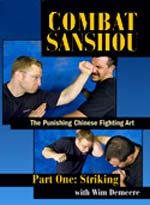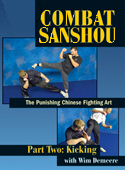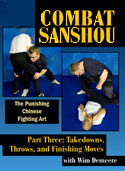Marc MacYoung?
Dianna Gordon MacYoung?
Animal E-list
Crime Avoidance Lectures
Crime Blog
Colorado Classes
Contact Us
FAQs
Hosting A Seminar
Crime Prevention
Expert Witness
Knife Defense
Law Enforcement
Martial Arts
Military
Movie Consulting
Women's Self-Defense
Links
Our Linking Policy
On-line Store
Train with MacYoung
Testimonials
Terms of Use
Topics
of Interest
I'm not here to feed your fantasies about violence.
Odds are someone fed you a load of BS about what it
takes
to survive a 'real' fight and why what they sold you
is
the ultimate fighting system. I'm here to keep you
from getting you throat slit if you ever need to use
it.
MM
On this page:
There Are Some Bad People out there |
What is patching? |
Common Patches
|
L.A.C. Test
Patching is basically taking a flawed and incomplete technique and plugging something in to make it work for YOU. The problem with this idea is that many 'patches' are specific to an individual (e.g. size, strength and speed). What this means is that although the technique is technically flawed, the person is able to make it 'work' by adding in this element.
The problems with this are legion:
1) Only someone who has those same attribute can make the
move
'work' the way the original person
teaches it.
2) The patched version only works against people who
are
a) less
skilled
b) less
experienced
c) smaller
d) weaker
e) slower
f) unfamiliar
with the technique
g) not coming
at you full force
h) not trying
to kill you.
3) Patched versions tend fall apart in situations where
you
a) aren't
fighting an inferior opponent
b) aren't
demonstrating on a cooperative uke
c) aren't in
the safety of the tournament ring
d) are facing
someone intent of injuring you
Basically when it comes to their use for self-defense, patched techniques work just fine if you only fight accountants and are only ever mugged by little old ladies. Unfortunately, you don't always get to pick and choose who's coming at you.
There Are Some Bad People out there
There is an old saying "90% of the problems are caused by 10%" of the people."
There is a lot of truth to this statement as is. But what a lot of people don't realize is that there are deeper implications. Implications that if you're thinking your MA training prepares you handle that 10% you had better think about. And once you've thought about it, you need to take a good hard look at your training.
The problem with how most people think of this 10% idea shows up when we write it out. 1,2,3,4,5,6,7,8,9,10. According to this nice neat model that 10% is safely ensconced way over yonder. (e.g. 1 or 10). By thinking of that 10% as a linear extreme it only directly effects the number immediately next to it (2 and 9). Well that's not to bad because that 10% is nicely isolated off in the boonies.
However, instead of thinking about those numbers in a linear scale model , we
want you to consider what it would look like if that 10% weren't comfortably
ensconced safely off at one end of the scale. In fact, look at the
bulls-eye of a target. While the much smaller center doesn't cover too much room itself, it touches a much
larger areas. However, that bulls-eye isn't 10%, the first ring is closer.
Now, instead of just effecting a small corner, that 10% idea. Now we have a much
bigger range of influence.
the much smaller center doesn't cover too much room itself, it touches a much
larger areas. However, that bulls-eye isn't 10%, the first ring is closer.
Now, instead of just effecting a small corner, that 10% idea. Now we have a much
bigger range of influence.
How much more of an area does it now effect? There's more area touching -- and thereby being effected by the original 10%. In fact, not only does a larger area connect to it, but it exists in all four quadrants. Using a linear scale you don't get this big of an area of influence.
What we would like you to do is to think about this new, larger, effected area as "most" fights. A segment of the 10% is causing trouble for a larger 25%. But the fact is, these fights are directed outward from the 10%. In other words, this is a portion of the 10% who are picking on those from the 90%.
What we really want you to understand is that the strategies and tactics that these people use constitute an overwhelming majority of "fights." And quite simply, the strategies and tactics that these people use is very effective...for who they are attacking. By attacking people who are not themselves in the 10%, simplistic strategies and flawed techniques work. And they work an overwhelming amount of the time!
See even though martial artists don't realize it, these violent people know as long as you go around picking on people who don't know how to fight, you'll be assured victory.
The problem is what happens if you turn your activities away from the 90% and inwards towards the bulls-eye. Because within the original 10% you encounter another a smaller subset. That middle dot is a BIG problem. That's because the closer to the center you get, the more competent -- and dangerous -- your adversaries become. That's because these guys are the scum de la scum when it comes to being very good and competent with violence. And although they are very small numerically, they too still touch all four sectors.
And here's the really bad news, both the 10% and that bulls-eye, while they normally spend their time in the same circles ... can get up and travel around. So you can run into either of them in any place. That isn't a scare tactic, but rather a statement of fact. The bad news is, the closer to the areas where they normally hang out, the more likely you are to run into them. The good news is the further away you are, the less likely. Even though the possibility does still exist. It really is less likely the further away you put yourself.
The problem with a lot of training these days is the mistaken belief that they are training themselves to handle this 10%. And this no matter where they are actually located on the target. While images of fighting off a deadly and ferocious streetfighter dances through the heads of many people in fact, most of the time, their training strategies more closely resemble what it would take to pick on someone from the 90%. Like we said, if they are planning on beating up an accountant they're ready.
When you point this out to them, they retort by pointing out how often this strategy IS successful. Well, the fact is, they're right. Punks, bullies and assholes around the world use that exact same strategy.
It is not, however, a good fighting strategy.
This is especially true if you are going to be facing people within the deeper core of that 10%. The outer ring of that circle are the people who specialize in picking on the 90%. While they may appear ferocious and dangerous to the 90%, within that 10%, they are the low men on the totem pole. They don't have what it takes to function within the deeper levels of the bulls-eye. In those circles, there is a whole lot more skill, cunning, prowess, experience and willingness to engage. You don't survive there by being sloppy. OR relying on simplistic and unreliable means.
Which brings us to the subject of "patching."
What is patching?
In the book
Becoming a Complete Martial Artist: Error Detection in the MA, our co-author
Tristan Sutrisno made a very important point. A point often forgotten in modern
training.
The purpose of the martial arts is weakness overcoming strength.
Think long and hard about that deceptively simple, but very profound statement.
Techniques are a means for a smaller weaker person to compensate against the advantages of a larger, stronger, faster, more aggressive and in other ways "enhanced" opponent. In fact, not only to compensate for, but to overcome those advantages. How do they do this? By effectively applying principles (such as distance), laws of physics and physiology (such as power delivery) and learned skills. The effective application of these elements render the advantages of the opponent useless.
That's the theory at least.
Patching occurs when someone who didn't/doesn't understand the elements that make for effectiveness, tried/tries to compensate for this lack by inserting the very elements that the technique was designed to compensate for.
Now that last sentence was grammatically weird. It did, however, say something very specific. And that is that the problem with patching has two fronts, first, what you were taught and, second, what you are doing.
Patching has been going on for a long time. It occurs when someone takes what is a personal strength and uses it to make a technique work. In doing so they tend to unconsciously drop small details that complete the technique. Details that other people need to make it work. For example someone who is strong enough to pick up a smaller opponent and throw him. That person will often be far less concerned about proper location (ma-ai) of a move. However, proper location and positioning is essential for a smaller person to make the technique work against a larger one. Here's the problem, what that larger person teaches reflects this lack within himself and his understanding. As such you will not learn these critical components from that individual. Therefore, while the technique will work for him, you will always struggle with it.
Yes, with enough practice -- and way too many failures -- you might, over time, unconsciously discover the location where you need to position yourself in order for it to work for you. As such, you will have somewhat of a hit or miss track record of finding that spot, even in the dojo. But, that technique will never be guaranteed against a larger, stronger and uncooperative opponent. This is an example of what you were taught blending into what you are doing to make it work.
But let's look at another one. Maybe you aren't as strong as your teacher, but you're faster. This would be another form of patching. A fast sloppy technique will often work against a smaller -- and even equal sized -- training partner if that person is not in balance or has structural flaws in how he's standing. It can even work in fights against untrained opponents of equal or lesser size. While it can work against a larger untrained, incompetent (or through a stroke of dumb luck regarding timing) opponent, the odds are against it. Your greater speed than that of your instructor is another form of patching. It's how you compensate for the flaws in what you were taught. It is not however, a complete, much less effective, technique.
What we want you to understand is that this is a systemic problem. That is to say it is a pattern, not an exception. Sure we all make mistakes and end up in the wrong place, position or whatever. Things go wrong, even with a cooperative uke. And quite frankly people try to compensate and make the move work anyway. That's why it's called "training." What we're talking about is when that becomes, not only ingrained, but considered the "right" way to do a move -- much less how to fight and/or how the system is done.
Common Patches
Patching comes in five main variants:
1) Strength,
2) Mass,
3) Speed
4) Physical fitness and
5) Attitude
Anytime someone tells you that any or all of these are what will guarantee you victory, you know you're dealing with a patched system. While they are all important, anytime you encounter someone who teaches you to rely on these over effective movement or clean technique, then you're dealing with something that will only work until you run across someone who has more of that attribute than you do.
L.A.C. Test (lack test)
What we'd like to give you now is a diagnostic tool.
Although originally designed to help martial artists
find what was wrong with what they were taught as
'traditional martial arts,' it can be applied to any
self-defense, defensive tactics and reality based
self-defense training. L.A.C. stands for
Lost
Added
Context
Lost is what has been lost from the system? By this, we also mean "what has been intentionally taken out?" Often in commercialized schools the more complex and harder to learn elements are stripped away for rapid advancement and retaining a large student base. For example, we sell a DVD set of the Fighting Footwork of Kuntao/Silat. Usually people think that fighting footwork is either kicking or stepping into position to punch or kick. And in sports based systems that is true, that is all footwork is. The DVD set shows how to attack using foot and legwork to disrupt your opponent's balance and structure, rendering him incapable of resisting. However, this element has been lost in most karate styles ... and yet, having met second generation students of Gichen Funakoshi and students of Shinjo, we have seen with our own eyes that this information was once in karate. Not as an advanced bunkai, but as a basic. Once you put this concept back into your karate, your katas take on entirely different -- and far more effective -- application.
Here is a consideration. Techniques are NOT supposed to be executed in a manner that could be summed up as "Oh when this lands you're going to be in soooo much trouble." If that is how your techniques work, then what you have been taught has been gutted. From the second you touch an opponent, his ability to attack (or resist) should be impaired. As you progress with the technique, it only gets worse for him. If during the execution of a technique at ANY time there is a break in the ongoing stream of force you are delivering into your opponent something has been lost. If what you are doing doesn't meet these standards, then something has been lost.
Added is first and foremost the bling-techniques that have been inserted into the martial arts to wow judges and improve showmanship at tournaments. The explanations for flashy moves like jump spinning heel kicks and flying jump side kicks usually have to do with knocking an armed soldier off a horse -- which is in a word -- ridiculous. Never mind the problems of knocking a mounted warrior off a horse, getting that high in full armour is impossible. Forget any stories about battlefield application, these moves are to win tournaments.
Another issue about added movement is a lot more
insidious.
It is when an instructor had not learned the move
properly and, although he had the ability to
patch it through speed or muscle, his students didn't.
They couldn't make it work the way he was teaching it.
So instead of going back to learn what he had lost, the
instructor added in extra movement to increase the moves
efficiency (yes, you read that right). This is an
example of one such addition ... and no, we arenot
making it up, we know of a school that taught a middle
hand knife block this way to increase the momentum of
the block.
Now trying to fix this move is basically impossible because the original problem has been compounded with extraneous movement. And unless you go and learn from another style, you will not know what the move was supposed to look like -- even in a weakened form. You can't fix what you don't know what the problem is.
Context is basically what is the move supposed to be? Unfortunately, a whole lot of mythology has been created to cover the fact that either the instructor didn't know what the move was for or to justify a bling-technique. For example, high jumping side kicks to knock a mounted warrior off a horse.
The problem with many of these explanations is that an otherwise legitimate move becomes mistaken for something else to fit with the instructor's limited understanding. For example we know of one series of moves where you step forward, drop both of your fists down and behind you. Then you reach up with your right hand to your ear, before turning to your left and kneeling.
When we asked about this technique we were told -- and I quote -- "You're stepping forward and groin striking two opponents behind you. Then you block the attack of the one on your right and turn and punch the one who has fallen on your left."
Needless to say we were not impressed. Then talking to an experienced Goju player, he said "Nonsense! It's breaking a bear hug, grabbing the guy's head and then a shoulder throw"
In that context the physics of the move became immediately clear. It obviously was a break away and a throw.
Look at anything you are taught -- and any explanation that you are given as to the application of a move in light of these three standards. Once you find the weaknesses in the move, then you can begin to more accurately search for ways to make them effective once more.



Meditations on Violence
Learn More >
Order Now!

Fighter's Guide to Heavy Bag
Training (DVD)
Learn More >
Order Now!

Fighter's Guide to Heavy Bag
Training (Book)
Learn More >
Order Now!

Street Fighting Essentials
Learn More >
Order Now!

Combat Sanshou: Striking
Learn More >
Order Now!

Taking It to the Streets
Learn More >
Order Now!

Far Beyond Defensive Tactics
Learn More >
Order Now!

Combat Sanshou: Kicking
Learn More >
Order Now!

Restraint and Control
Strategies
Learn More >
Order Now!

Combat Sanshou:
Takedowns/Throws
Learn More >
Order Now!

Secrets of Effective Offense
Learn More >
Order Now!

Escape Combatives
Special Bonus Feature
ESCAPE DRIVING
Learn More >
Order Now!

Experience- & Reality-Based
Self-Defense
Learn More >
Order Now!

Martial Arts America
Learn More >
Order Now!

Pukulan Pentjak Silat
Learn More >
Order Now!

Real World Self-Defense
Learn More >
Order Now!

Fighting Footwork of
Kuntao/Silat Volume 2
Learn More >
Order Now!

A Bouncer's Guide to
Barroom Brawling
Learn More >
Order Now!

Fighting Footwork of
Kuntao/Silat Volume 3
Learn More >
Order Now!

Dead Or Alive
Learn More >
Order Now!

Fighting Footwork of
Kuntao/Silat Volume 4
Learn More >
Order Now!

Championship Streetfighting
Learn More >
Order Now!

Minimum Damage, Maximum Effect
Learn More >
Order Now!
| About navigating this site | Animal List | Bibliography | Bullies | Burglary while on vacation | Classes in Colorado | Car Jacking | Children and Martial Arts | Child Safety | Criminal Mindset | Cults in MA/SD | De-Escalation | E-mail Dianna | E-mail Marc| FAQs | Have MacYoung speak about crime avoidance | Home Page | Home Defense | Hosting a Seminar | Fear | Five Stages of Crime | Knife Fighting | Legal Issues | LEO/Correctional Officer/EMS | Linking policy | Links | Martial Arts | Photo Gallery | Property Crime | Psychology | Rape | Robbery | Safe Dating | Self-Defense Training | Selling your books/DVDs on NNSD | Seminar Schedule | Stalking/Domestic Violence | Street Fighting | Terms of Use | Testimonials | Train with Marc MacYoung | Who is Dianna Gordon MacYoung? | Who is Marc "Animal" MacYoung? | Victimhood | Workplace Problems | Zero Tolerance | ||
| ? 1998-2008 No Nonsense Self-Defense, LLC. All rights reserved. |